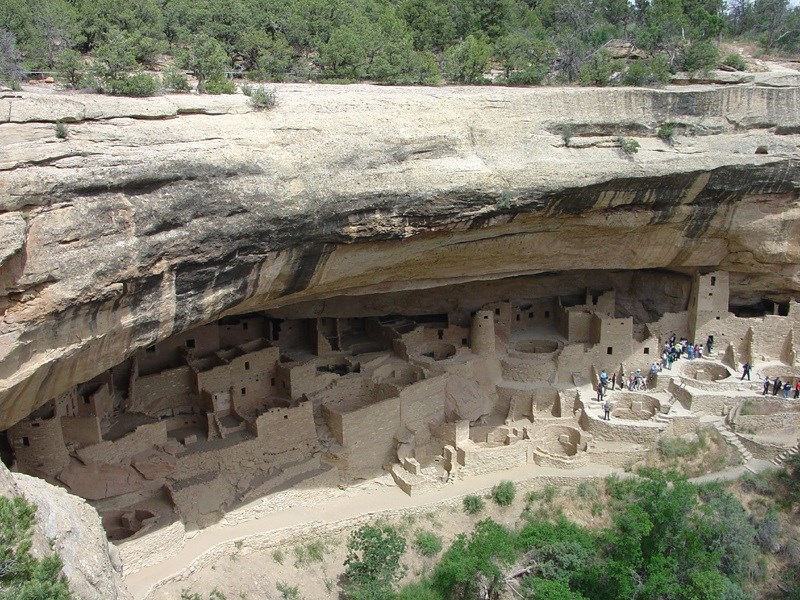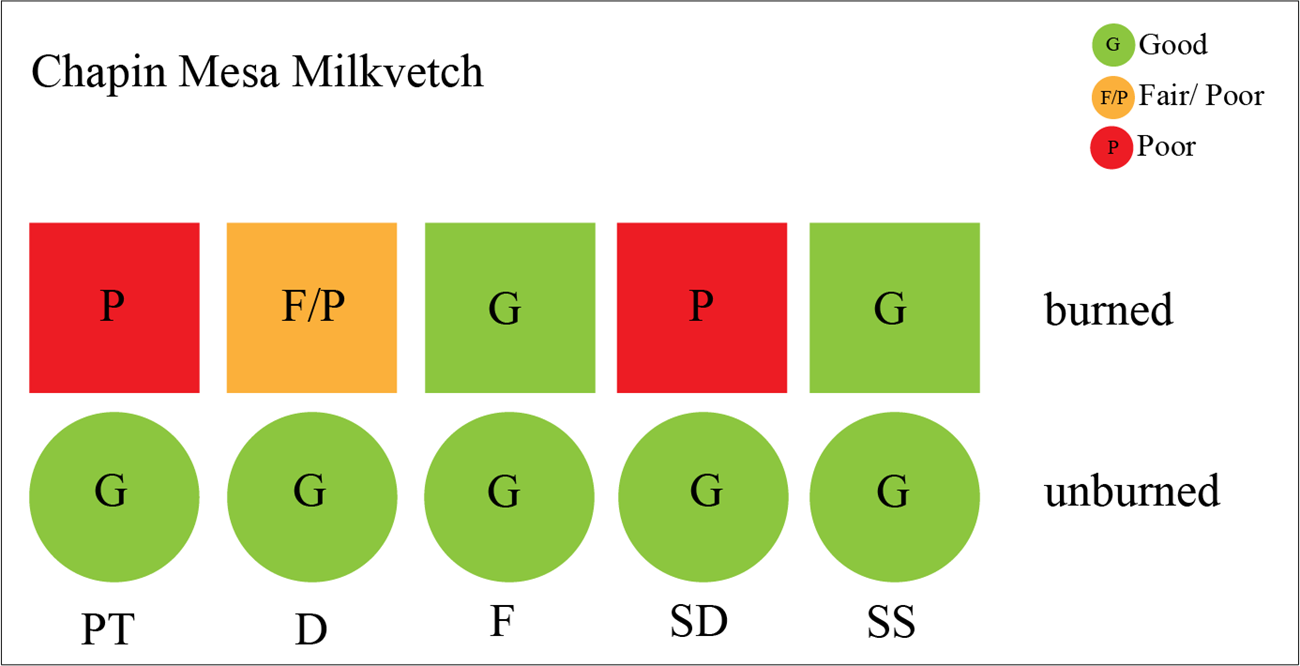Part of a series of articles titled Condition of Selected Natural Resources at Mesa Verde National Park: A 2025 Assessment.
Article
Rare Plants in a Colorado Rare-Plant Hot Spot—Mesa Verde National Park
A 2025 Natural Resource Condition Assessment evaluated six resources at Mesa Verde National Park. This article describes what we learned about the condition of rare plants.

Colorado Natural Heritage Program / Renee Rondeau
Rare Plants was one of six resources included in the 2025 Natural Resource Condition Assessment (NRCA) for Mesa Verde National Park (NP). The park is one of eight hotspots in Colorado for rare and endemic plants (Rondeau et al. 2011). There are currently 14 rare native plants of conservation concern in Mesa Verde. The surveyed areas of rare species in the park range from only 1 acre of known occupied habitat for the giant hellebore (Epipactis gigantea) to about 2,000 acres of known occupied habitat for the Chapin Mesa milkvetch (Astragalus schmolliae) (Colorado Natural Heritage Program 2023). Four of the 14 species are endemic to the Four Corners Region, including the closely monitored Cliff Palace milkvetch (Astragalus deterior) and Chapin Mesa milkvetch (Astragalus schmolliae).
For this study, the NRCA team (led by Conservation Science Partners) assessed rare plants through three analyses: 1) a gap analysis for the 14 rare native plants of conservation concern, 2) a gap analysis for Cliff Palace milkvetch, and 3) a condition assessment for Chapin Mesa milkvetch. A condition assessment is a more thorough evaluation of a resource’s current condition, while a gap analysis highlights what we know and don’t know about a resource. Data availability determines which type of study the team conducts. An overview article explains the NRCA project and the other resources assessed for Mesa Verde.
For the Full Story...
14 Rare Plants Gap Analysis
For the rare plants gap analysis, the NRCA team used information from the Colorado Natural Heritage Program (CNHP). This information was on known locations of the rare plants within the park, the approximate density of plants within surveyed areas, and CNHP’s “element occurrence ranks,” which estimate the degree of health of the populations (from healthy to extirpated). The NRCA team also used the Rangeland Analysis Platform (RAP) dataset from 2023. With this dataset, they looked at the extent of non-native plants that occur within areas where Mesa Verde’s rare plants are found; some rare plant species are negatively affected by non-native annual forbs and grasses. Additionally, the NRCA team overlaid perimeters of fires that occurred since 1970 onto the rare plant map. This helped them see how much fire has disturbed the surveyed rare plant locations.
The NRCA team produced maps of species occurrence within the park and a table summarizing other information collected over the past 25 years. The team found that the three species with the highest percent cover of annual grasses and forbs within their surveyed areas were Arizona gumweed (Grindelia arizonica), Chapin Mesa milkvetch, and alkali pepperweed (Lepidium crenatum) (8.7%, 4.8%, and 4.1%, respectively). Regarding fire, the NRCA team found that the distributions of nine of the plants overlapped with fires since 1970. Post-1970 fires overlapped with approximately 17% (570 out of 3,300 acres) of these nine plants’ survey locations.
Cliff Palace Milkvetch Gap Analysis
Cliff Palace milkvetch is a short-lived perennial forb. It usually grows to less than 2 inches (5 cm) long. It grows only with a specific type of rock—the white zone of the Upper Cliff House Sandstone—at the south rim of Mesa Verde NP (Center for Plant Conservation 2020). The plant is found in shallow sandy soils on the rocky mesa rims and slopes with deposits from the Upper Cliff House Formation. Fires in 2000 and 2002 (the Pony Fire and Long Mesa Fire, respectively) burned part of Mesa Verde’s population of Cliff Palace milkvetch.

U.S. Geological Survey
The NRCA team conducted a separate (from the other rare plants) gap analysis for this plant species. The team used monitoring data for Cliff Palace milkvetch from 2003 to 2007 and 2021 to 2022. The data were from surveys of 11 permanent transects in burned and unburned areas. Monitoring information included the density of Cliff Palace milkvetch and counts of seedling plants.
Gap analysis results for Cliff Palace milkvetch revealed a dramatic, concerning decline in its population across both burned and unburned habitats in Mesa Verde (2003–2007 data compared to 2021–2022 data). The average density of Cliff Palace milkvetch dropped by 95% in burned transects and 80% in unburned transects. Additionally, the study of Cliff Palace milkvetch seedling data showed a decline in the abundance of seedlings from 2007 to 2022 in burned and unburned areas. Warming temperatures and drought related to climate change might be causing the species to decline. Also, accidental trampling by park visitors and other disturbance could be adding to the decline.
Chapin Mesa Milkvetch Condition Assessment
Chapin Mesa milkvetch is the most studied plant in Mesa Verde NP. The plant is endemic to the Chapin Mesa of Mesa Verde NP, with some small, outlying populations on Park Mesa (just east of Chapin Mesa). The species is found within intact pinyon-juniper (PJ) woodlands, with old-growth PJ the preferred habitat (Rondeau et al. 2022). The plant is dormant during the winter and does not sprout any above-ground stems. It can also be dormant outside of winter if the soil isn’t moist enough at depths of about 14 to 18 inches (35–45 cm).

Colorado Natural Heritage Program / Renee Rondeau
In 2002, the Long Mesa Fire burned about 38% of the area known to be occupied by Chapin Mesa milkvetch. After the fire, park managers seeded the Chapin Mesa burned area with native grasses, including western wheatgrass (Pascopyrum smithii), to prevent the intrusion of non-native cheatgrass (Bromus tectorum) and other non-native forbs. Western wheatgrass increased more in the burned areas than it naturally would have and competed with all age classes of Chapin Mesa milkvetch, further threatening the plants in the burned areas.
For the condition assessment, the NRCA team used monitoring data from 2001, 2003, 2011–2014, and 2015–2023. This data came from the Colorado Natural Heritage Program. Not all of the data were used in all analyses because of some differences in how the data were collected in different years.
The condition assessment included indicators for the following components, assessed separately for unburned and burned populations:
- Population trend (individual plants per square meter)
- Demography (age class distributions)
- Fruit production (fruit per square meter)
- Seedling density (seedlings per square meter)
- Seedling survival
Although not provided here, the NRCA team used specific criteria to decide if condition was good, fair, poor, etc. for each indicator. When possible, they used quantitative (numerical or countable) criteria, but they also used qualitative (descriptive and non-numerical) criteria.
The condition assessment for Chapin Mesa milkvetch revealed very different condition ratings depending on whether populations were in burned or unburned habitats (Figure 1). Fruit production (F) and seedling survival (SS) were rated as good in both unburned and burned habitats. However, population trend (PT), demography (D), and seedling density (SD) were rated as good in unburned habitats, but poor, fair/poor, and poor, respectively, in burned habitats.

NPS
Figure 1. Summary graphic of the five Chapin Mesa milkvetch indicators of condition, from left to right—population trend (“PT”), demography (“D”), fruit production (“F”), seedling density (“SD”), and seedling survival (“SS”), respectively. Circles are for populations in unburned habitat and squares are for populations in burned habitat.
What can park managers do with this information?
The assessment will help guide planning, stewardship, and management for rare plants in Mesa Verde NP. The NRCA process resulted in a number of recommended considerations for monitoring and management, a few of which are mentioned here:
-
Consider developing and implementing a monitoring plan and protocol for the rare plant species that are most at risk in Mesa Verde. Vulnerable species, in addition to the two milkvetches, include Mesa Verde stickseed (Hackelia gracilenta; pictured above) and Gray’s Townsend daisy (Townsendia glabella). Include recordings of impacts from visitation, park infrastructure, and other factors in monitoring efforts.
-
Investigate how to address threats to Cliff Palace milkvetch to ensure its persistence in the park. The plant has recently declined within the park, and there are documented threats to it from accidental trampling by visitors on trails, impacts from park infrastructure (such as roads and waterlines), erosion, changes in climate, and non-native species.
-
Continue and expand monitoring for Cliff Palace milkvetch, including of the seed bank. The NRCA team made several suggestions for future monitoring. These include to continue to monitor plots established in 2004–2007, while also expanding monitoring to additional locations and transects. This would help park mangers gain a better understanding of the species across the park.
-
As part of the ongoing, regular monitoring of Chapin Mesa milkvetch, factor in dormancy rates when estimating total counts of the species. Factoring in dormancy rates leads to more representative population estimates. Other related recommendations include the collection of density data across all 2001 baseline transects to provide a more comprehensive understanding of the species’ population estimates (Rondeau 2023).
Glossary
- An endemic species is an organism that is native and restricted to a certain place or region.
- A forb is an herbaceous (non-woody) flowering plant that is not a grass or grass-like plant.
- Perennial plants live for more than two years and usually come back year after year.
References
Colorado Natural Heritage Program. 2023. Biodiversity Tracking and Conservation System. GIS data. (Data exported October 2023). Colorado State University.
Rondeau, R. 2020. Long-term population trends and environmental attributes of the imperiled Chapin Mesa milkvetch (Astragalus schmolliae) 2019 Report. Colorado Natural Heritage Program, Colorado State University. Available at https://cnhp.colostate.edu/download/documents/2020/MEVE2019MonitoringReport_final_external.pdf (Last accessed 13 February 2025).
Rondeau, R. 2023. Monitoring the imperiled Chapin Mesa milkvetch (Astragalus schmolliae): 2022 progress report on long-term population trends and environmental attributes. Colorado Natural Heritage Program, Colorado State University.
Rondeau, R., K. Decker, J. Handwerk, J. Siemers, L. Grunau, and C. Pague. 2011. The state of Colorado’s biodiversity. Prepared for The Nature Conservancy by the Colorado Natural Heritage Program, Colorado State University, Fort Collins, Colorado. Available at https://cnhp.colostate.edu/wp-content/uploads/download/documents/the_state_of_colorados_biodiversity.pdf.
Rondeau, R., D. Anderson, J. Handwerk, and T. Spector. 2022. Post-fire effects on the globally imperiled Chapin Mesa milkvetch (Astragalus schmolliae), 2001–2019. Natural Areas Journal 42(1):4–17. Available at https://doi.org/10.3375/21-14.
Last updated: June 27, 2025
